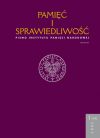Pomiędzy współpracą a zdradą. Problem kolaboracji w Generalnym Gubernatorstwie – próba syntezy
Between Cooperation and Treason. The Problem of Collaboration in the General Government
Author(s): Jacek Andrzej MłynarczykSubject(s): History
Published by: Instytut Pamięci Narodowej
Summary/Abstract: Under the notion of “collaboration”, the author understands any assistance to the occupation authorities that explicitly threatened the interest of the conquered people and state. On the other hand, assistance given to the enemy authorities in order to sustain the occupied territory’s vital state institutions and to protect, as far as possible, the people against the effects of war is treated by the author as “cooperation”. The author analysed this phenomenon in the General Government and concluded that representatives of occupation institutions provided a relatively narrow cooperation platform for the conquered Poles which strongly limited possibilities of advanced collaboration in the area. Even so, collaboration on several different planes did occur in the General Government, although to a limited extent. Collaborative behaviours were occurring, inter alia, on the political plane, even though Germans were not directly interested in political cooperation with Poles as they aimed to eliminate the Polish intelligentsia and reduce the rest of the society to the role of a primitive labour force. An example of political activities bordering on collaboration was Professor Władysław Studnicki’s attempts to come to an arrangement with Germans. Other forms of collaborative behaviours included individual or group participation in anti-Jewish riots resulting from the pre-war anti-Semitism of some Poles. The group of organisations intending to build their political capital through participation in anti-Jewish pogroms included National Radical Organisation (Narodowa Organizacja Radykalna) and “Atak” (“Attack”). Unmistakably collaborative behaviours were also taking place on the military and paramilitary plane. Even though top leaders of Third Reich were reluctant to form Polish armed divisions, in the autumn of 1944 they launched a campaign intended to recruit Poles to “Polish Wehrmacht”, which was to fight alongside Germans against the approaching Red Army. In spite of the obviously imminent collapse of the Nazi empire, the unit was joined by 699 people, some of whom were conscripted to “Hitler Jugend” due to young age. Others were distributed among different military units. Another example bordering on paramilitary collaboration was the activities of Polish, Jewish and Ukrainian police forces. They were being used by the enemy to perform operations clearly colliding with vital interests of the conquered people. Also, each official employed in occupation public institutions and civil administration too eager to perform his/her enemy-imposed duties contravening the Polish raison d’état was crossing the thin line separating cooperation from collaboration. Another field where the line of permitted behaviour towards the enemy was being relatively easily crossed was culture and art. Particularly susceptible to collaboration were those writers and journalists who worked for the Nazi-controlled press titles published in the GG.
Journal: Pamięć i Sprawiedliwość.
- Issue Year: 14/2009
- Issue No: 1
- Page Range: 103-132
- Page Count: 30
- Language: Polish

